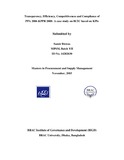Transparency, efficiency, competitiveness and compliance of PPA 2006 &PPR 2008: a case study on BCIC based on KPIs
Abstract
Transparency, efficiency, competitiveness and free & fair competition are inevitable objectives to
be ensured in the procurement using public funds in the government sector of Bangladesh. The
present study was undertaken to assess the above objectives in the procurement process of BCIC, a
large corporation of Bangladesh. A semi-structured questionnaire was used to measure perception
of procurement professionals of various factories of BCIC. The Central Procurement Technical Unit
(CPTU) of the Implementation Monitoring and Evaluation Division (IMED) is continually
monitoring the compliance of PPA 2006 and PPR 2008 by the in the light of 45 predetermined Key
Performance Indicators (KPIs).
The target agencies of CPTU are BWDB, RHD, LGED and REB. Their procurement activities are
monitored and evaluated by CPTU for the purpose of overseeing the performance of those agencies
in the light of PPA 2006 and PPR 2008 against the preset 45 KPIs. But BCIC is not the target
agency although BCIC is engaged in spending huge funds behind procurement of goods, services,
works, in each financial year which requires to be paid a good attention on the compliance issues
along with transparency, efficiency, competitiveness of PPR 2008 in procurement activities of
BCIC. Hence, it is attempted to apply those preset KPIs for measuring the transparency, efficiency,
competitiveness and compliance of PPR 2008 in BCIC in the field of procurement.
The response of procurement practitioners’ were comparatively better in KPI 6 (Average number
of days between publishing of advertisement and Tender submission deadline), KPI 11 (Percentage
of cases TOC included at least ONE member from TEC), KPI 13 (Percentage of cases TEC
included two external members outside the Ministry or Division), KPI 20 (Percentage of Tender
approved by the proper financial delegated authority), KPI 25 (Average number of days between
final approval and Notification of Award (NOA) and KPI 33(Average number of days taken for
release payment from the date of certification of PM/Engineer) in respect of compliance compared
with others.
The perception were better in adherence of KPI 1 [Percentage of Invitation for Tender (IFT)
published in Newspaper] and KPI 2[Percentage of Invitation for Tender (above threshold)
advertised in CPTU’s website] compared to KPI 8(Average number of Tenders purchased Tender
Documents) in terms of transparency.
The result showed procurement performance of BCIC in respect of efficiency KPI 22 (Percentage
of cases contract award decision made within timeline by Contract approving Authority after
submitting Tender evaluation report), KPIs 29 (Percentage of Contract awarded within initial
Tender validity period) and KPI 30 (Percentage of Contracts completed / delivered within the
original schedule as mentioned in the contract) were almost similar whereas KPI 15 was little bit
lagging behind in respect of other aforesaid three KPIs.
In regard to competitiveness of procurement process in BCIC KPI 6(Average number of days
between publishing of advertisement and Tender submission deadline) scored the far better in
comparison with other KPIs under the competitiveness arena.
The research has been framed under the questions whether BCIC is following PPR 2008 completely
or not; and if not, then the causes behind that. The main objectives of the present study are to find
out the extent of transparency, efficiency, competitiveness and compliance of PPR 2008 by BCIC in
the aspect of procurement and to find out the gap of compliance and scope of improvement for
implementation. In order to conduct this research work relevant literatures and reports, thesis work
particularly from BIGD, BRAC University, CPTU, SRGB have been thoroughly studied prior to
carrying out the research work. The focal and key findings and result of these reports have been
compared and analyzed at the level best in order to get aid for reaching to the conclusion of this
thesis despite of some reported challenges and limitations.
A questionnaire survey was carried out to collect primary data from different stakeholders related to
procurement activities of BCIC and its controlled companies located in different district of
Bangladesh. For the purpose of in depth study on the transparency, efficiency, competitiveness and
compliance issues of PPR 2008, five different companies and BCIC Head Quarter’s Purchase
Division were studied carefully to collect the qualitative data also. In addition to survey, key
informant interviews have been conducted to get the perceptions of few senior officers of BCIC and
different companies. The results based on above KPIs and categories found that BCIC’s
procurement performance is better in compliance followed by transparency, efficiency and
competitiveness.

